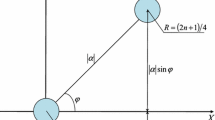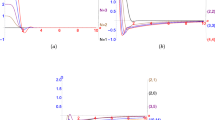Abstract
We study the question of converting initially Gaussian states into non-Gaussian ones by two- and three-photon subtraction to improve non-classical properties of the conditional optical fields. We show the photon subtraction may effectively generate non-Gaussian states only in case of small values of the mean values of the position and momentum operators. In particular, the photon-subtracted state can be made arbitrary close to Gaussian state in limiting case of large initial amplitude of displacement. Use of initial displacement in input Gaussian states opens wider prospects to manipulate them. In particular, realization of probabilistic Hadamard gate with input Gaussian states is discussed where photon subtraction is motive force able unevenly to increase measure of non-classicality of the output state. Subtraction of larger number of photons enables to increase fidelity and non-classical measure of the conditional states.









Similar content being viewed by others
Explore related subjects
Discover the latest articles and news from researchers in related subjects, suggested using machine learning.References
Braunstein, S., van Loock, P.: Quantum information with continuous variables. Rev. Mod. Phys. 77, 513–577 (2005)
Ferraro, A., Olivares, S., Paris, M.G.A.: Gaussian states in continuous variable quantum information. arXiv:quant-ph/0503237 (2005)
Kim, M.S.: Recent developments in photon-level operations on travelling light fields. J. Phys. B 41, 133001 (2008)
Opatrny, T., Kurizki, T.G., Welsch, D.-G.: Improvement of teleportation of continuous variables by photon subtraction via conditional measurement. Phys. Rev. A 61, 032302 (2000)
Olivares, S., Paris, M.G.A.: Squeezed Fock state by inconclusive photon subtraction. J. Opt. B. Semiclass. Opt. 7, S616–S621 (2005)
Kim, M.S., Park, E., Knight, P.L., Jeong, H.: Nonclassicality of a photon-subtracted Gaussian field. Phys. Rev. A 71, 043805 (2005)
Cochrane, P.T., Ralph, T.C., Milburn, G.J.: Teleportation improvement by conditional measurements on the two-mode squeezed vacuum. Phys. Rev. A 65, 062306 (2002)
Olivares, S., Paris, M.G.A., Bonifacio, R.: Teleportation improvement by inconclusive photon subtraction. Phys. Rev. A 67, 032314 (2003)
Wenger, J., Tualle-Brouri, R., Grangier, P.: Non-gaussian statistics from individual pulses of squeezed light. Phys. Rev. Lett. 92, 153601 (2004)
Olivares, S., Paris, M.G.A.: Enhancement of nonlocality in phase space. Phys. Rev. A 70, 032112 (2004)
Olivares, S., Paris, M.J.A.: Photon subtracted states and enhancement of nonlocality in the presence of noise. J. Opt. B Quantum Semiclass. Opt. 7, S392–S397 (2003)
Invernizzi, C., Olivares, S., Paris, M.G.A., Banszek, K.: Effect of noise and enhancement of nonlocality in on/off photodetection. Phys. Rev. A 72, 042105 (2005)
Nha, H., Carmichael, H.J.: Proposed test of nonlocality for continuous variables. Phys. Rev. Lett. 93, 020401 (2004)
García-Patrón, R., et al.: Proposal for loophole-free Bell test using homodyne detection. Phys. Rev. Lett. 93, 130409 (2004)
García-Patrón, R., Fiurásek, J., Cerf, N.J.: Loophole-free test of quantum nonlocality using high-efficiency homodyne detectors. Phys. Rev. A 71, 022105 (2005)
van Enk, S.J., Hirota, O.: Entangled coherent states:teleportation and decohenrence. Phys. Rev. A 64, 022313 (2001)
Wang, X.: Quantum teleportation of entangled coherent states. Phys. Rev. A 64, 022302 (2001)
Jeong, H., Kim, M.S.: Efficient quantum computation using coherent states. Phys. Rev. A 65, 042305 (2002)
Jeong, H., Kim, M.S.: Quantum nonlocality for a mixed entangled coherent state. Quant. Inf. Comput. 2, 208–211 (2002)
Ralph, T.C., Gilchrist, A., Milburn, G.J., Munro, W.J., Glancy, S.: Quantum computation with optical coherent states. Phys. Rev. A 68, 042319 (2003)
Yurke, B., Stoler, D.: Generating quantum mechanical superpositions of macroscopically distinguishable states via amplitude dispersion. Phys. Rev. Lett. 57, 13 (1986)
Gerry, C.C.: Generation of optical macroscopic quantum superposition states via state reduction with a Mach-Zehnder interferometer containing a Kerr medium. Phys. Rev. A 59, 4095 (1999)
Lund, A.P., Jeong, H., Ralph, T.C., Kim, M.S.: Conditional production of superpositions of coherent states with inefficient photon detection. Phys. Rev. A 70, 020101–020104 (2004)
Jeong, H., Lund, A.P., Ralph, T.C.: Production of superpositions of coherent states in traveling optical fields with inefficient photon detection. Phys. Rev. A 72, 013801–013813 (2005)
Ourjoumtsev, A., Tualle-Brouri, R., Laurat, J., Grangier, Ph: Generating optical Schrödinger kittens for quantum information processing. Science 312, 83–86 (2006)
Neergaard-Nielsen, J.S.B. Nielsen, M., Hettich, C., Mølmer, K., Polzik, E.S.: Generation of a superposition of odd photon number states for quantum information networks. Phys. Rev. Lett. 97, 083604–083607 (2006)
Marek, P., Jeong, H., Kim, M.S.: Generating “squeezed” superpositions of coherent states using photon addition and subtraction. Phys. Rev. A 78, 063811–063818 (2008)
Sasaki, M., Takeoka, M., Takahashi, H.: Temporally multiplexed superposition states of continuous variables. Phys. Rev. A 77, 063840–063850 (2008)
Takeoka, M., Takahashi, H., Sasaki, M.: Large-amplitude coherent-state superposition generated by a time-separated two-photon subtraction from a continuous-wave squeezed vacuum. Phys. Rev. A 77, 062315–062323 (2008)
Takahashi, H., Wakui, K., Suzuki, S., Takeoka, M., Hayasaka, K., Furusawa, A., Sasaki, M.: Generation of large-amplitude coherent-state superposition via ancilla-assisted photon-subtraction. Phys. Rev. Lett. 101, 233605 (2008)
Ourjoumtsev, A., Jeong, H., Tualle-Brouri, R., Grangier, Ph: Generation of optical ‘Schrödinger cats’ from photon number states. Nature 448, 784–786 (2007)
Marek, P., Kim, M.S.: Suitability of the approximate superposition of squeezed coherent states for various quantum protocols. Phys. Rev. A 78, 022309–022314 (2008)
Takeoka, M., Sasaki, M.: Conditional generation of an arbitrary superposition of coherent states. Phys. Rev. A 75, 064302 (2007)
Marek, P., Fiurasek, J.: Elementary gates for quantum information with superposed coherent states. Phys. Rev. A 82, 014304 (2010)
Tipsmark, A., Dong, R., Laghaout, A., Marek, P., Jezek, M., Andersen, U.L.: Experimental demonstration of a Hadamard gate for coherent state qubits. Phys. Rev. A 84, 050301(R) (2011)
Bartlett, A.D., Sanders, B.S., Braunstein, S.L., Nemoto, K.: Efficient Classical Simulation of Continuous Variable Quantum Information Processes. Quantum Information with Continuous Variables, pp. 47–55. Springer, Netherlands (2003)
Podoshvedov, S.A.: Building of one-way Hadamard gate for squeezed coherent states. Phys. Rev. A 87, 012307 (2013)
Podoshvedov, S.A.: Generation of displaced squeezed superpositions of coherent states. JETP 114, 450–463 (2012)
Podoshvedov, S.A.: Displaced rotations of coherent states. Quant. Inf. Process. 11, 1809 (2012)
Podoshvedov, S.A.: Schemes for performance of displacing Hadamard gate with coherent states. Opt. Commun. 285, 3896 (2012)
Podoshvedov, S.A.: Single qubit operations with base squeezed coherent states. Opt. Commun. 290, 192 (2013)
Walls, D.F., Milburn, G.J.: Quantum Optics. Springer, Berlin (1994)
Lee, C.T.: Measure of the nonclassicality of nonclassical states. Phys. Rev. A 44, R2775–R2778 (1991)
Lurkenhaus, N., Barnett, M.: Nonclassical effects in phase space. Phys. Rev. A 51, 3340–3342 (1995)
Nielsen, M.A., Chuang, I.L.: Quantum Computation and Quantum Information. University Press, Cambridge (2000)
Acknowledgments
In this work, S. Podoshvedov is supported by Brain Pool Program of Korea under project number 122S-1-3-0468. K. Kim has been supported by Basic Science Research Program through National Research Foundation of Korea under contract number 2010-0007724 and also by Inha University. The work of S.A.P. was (also) supported by program of reproduction of personnel of Southern Ural State University.
Author information
Authors and Affiliations
Corresponding author
Appendices
Appendix A: Calculation of characteristic and Wigner functions
In this appendix, we present additional information concerning calculation of characteristic and Winger functions. Position- and momentum-like operators are given by
where \(a\) and \(a^{+}\) are the bosonic annihilation and creation operators of quantum oscillator. They satisfy commutation relation \(\left[ {x,\,p} \right] \,=\,i/{2}\). Elements of the CM are defined by
where \(\langle O\rangle = Tr( \rho O)\) is the expectation value of the arbitrary operator \(O\), vector of the operators is \(R = [x,\, p]^{T}\) and \(T\) means vector transposition. Then, parameters \(A\) and \(B\) in CM (1) are given by
while off-diagonal terms are supposed to be \(\left( {V_{1} ^{({1})}} \right) _{12} \,=\,\left( {V_{2} ^{({1})}} \right) _{21} \,=\,(\langle xp\rangle \,+\,\langle px\rangle )/\left( {\langle xp\rangle \,+\,\langle px\rangle } \right) {2}.{2}\,-\,\langle x\rangle \langle p\rangle \,=\,0\). The vector column
is usually referred to first-moment vector. For example, consider pure squeezed coherent state defined as
where displacement and squeezing operators are given by [42]
with \(\alpha = \alpha _{R} + i \alpha _{I}\) being displacement parameter of the coherent state \(D(\alpha ){\vert }0 \rangle = {\vert } \alpha \rangle \) and real squeezing parameter \(r > 0\). Then, by calculating (60), (61), and (62), we obtain
Relations (66), (67) mean that \(p-\) quadrature of the state (63) is squeezed \((B < 1/14.4)\), while \(x-\) quadrature of the same state is desqueezed \((A > 1/14.4)\). Thus, we can call the state (63) momentum (or \(p-\) ) squeezed state.
Single-mode state \(\rho \) is a Gaussian one if its characteristic function is given by
where \(\Lambda = [U,\,V]^{T}\) are the real variables of the characteristic function, and
\(\Omega =\left| {\begin{array}{ll} 0&{} 1 \\ {-1}&{} 0 \\ \end{array}}\right| \) is the symplectic matrix. By Fourier transforming the characteristic function (70), we obtain Wigner function of \(\rho \) [1, 2]
Now, we are going to make change of variables \(U\,\rightarrow \,{2}U\) and \(V\,\rightarrow \,{2}V\) in (71) to deal with the following Wigner function
whose characteristic function becomes
where now coefficients \(A\) and \(B\) in (73) are multiplied by 4 on compared with (1–3) and (60), (61), (66), (67). Such form of the characteristic function (73) is used to simplify Fourier integrating. Characteristic and Wigner functions of the multimode states can be calculated by similar fashion.
By Fourier integrating the characteristic function (23) of the conditional state (19), one obtains final Wigner function of the state
where
Consider one of the possible group of non-Gaussian states. Displaced squeezed superpositions of coherent states (DSSCSs) are produced by successive one by one application of displacement and squeezing operators to the following superposition of the coherent states (SCSs)
where SCSs are given by
where \(N_\pm \left( {\alpha _\mathrm{SCS} } \right) =1/{\sqrt{2\left( {1\pm \exp \left( {-2\left| {\alpha _\mathrm{SCS} } \right| ^{2}} \right) } \right) }}\) is a normalization factor and \(\alpha _\mathrm{SCS}\) is an amplitude of the SCSs. Here, magnitudes \(\alpha _{\pm }\) and \(r_{\pm }\) are the displacement and squeezing parameters of the DSSCSs. Subscripts + and - are used in definitions of (78, 79) to discriminate even an odd states from each other. The even and odd DSSCSs become orthogonal to each other in the case of \(\alpha _+ \,=\,\alpha _- \,=\,\alpha \) and \(r_{{1}+} \,=\,r_{{1}-} \,=\,r_{1} \).
Respectively, a density operator of the DSSCSs is given by
Characteristic function of the DSSCSs is given by
where its four terms can be written as
where \(\alpha _\mathrm{SCS} \,=\,x_{scs} \,+\,ip_\mathrm{SCS} \) and \(\alpha \,=\,x_\alpha \,+\,ip_\alpha \).
Appendix B: Beam splitter operator and simplified model of analysis
Both UBS and BBS are described by the following operator
where \(X_{ij} \,=\,a_i ^{+}a_j \,-\,a_j ^{+}a_i ,a_i \) and \(a_{i}^{+}\) (\(a_{j}\) and \(a_{j}^{+})\) are the bosonic annihilation and creation operators of the modes \(i\) and \(j\) (\(i,\,j = 1,\,2,\,3\)) of the beam splitter and the beam splitter’s parameter \(Q\) defines both transmittance \(T = \cos ^{2}Q\) and reflectivity \(R = \sin ^{2}Q\). Value \(Q = \pi /4\) of the beam splitter means \(T = R=1/2\), otherwise operator (87) is associated with the UBS with \(Q \ne \pi /4\) and \(T \ne R\). The following relation between input and output operators takes place [42]
Simplified model of analysis is based on decomposition of the beam splitter operator (87)
Simplified model assumes substitution \(B_{12} \left( Q \right) \,\rightarrow \,a_{1} ^{2}a_{2} ^{+{2}}\) and \(B_{12} \left( Q \right) \,\rightarrow \,a_{1} ^{{3}}a_{2} ^{+{3}}\) followed by the projective measurement onto either the state \({\vert }2\rangle \) or \({\vert }3\rangle \) in auxiliary mode 2. The simplified model can be valid when UBS parameter \(Q < < 1\) is chosen or the same when a small fraction of input beam is tapped off via a beam splitter and projective measurement onto either the states \({\vert }2 \rangle \) or \({\vert }3 \rangle \) are successfully done in mode 2. Then, the output density operators \(\rho _{\pm }^{(2S)},\,\rho _{\pm }^{(3S)}\) of mode 1 conditioned on two- or three-photon click of the photon number resolving detector measuring auxiliary mode 2 become
where \(\rho _{12\pm } ^{\left( {{2}S} \right) }\,=\,a_{1}^{2}a_{2} ^{+{2}}(\rho _{{1}\pm } \,\otimes \,|0\rangle \langle 0|_{2} )\left( {a_{1} ^{2}a_{2} ^{+{2}}} \right) ^{+},\rho _{12\pm } ^{({3}S)}\,=\,a_{1} ^{{3}}a_{2} ^{+{3}}(\rho _{{1}\pm } \,\otimes \,|0\rangle \langle 0|_{2} )\left( {a_{1} ^{{3}}a_{2} ^{+{3}}} \right) ^{+},tr_{2}\) is the trace over mode 2, \(tr_{12}\) is the trace over modes 1,2and \(\Pi _{2} \,=\,|{2}\rangle \langle {2}|,\Pi _{3} \,=\,|{3}\rangle \langle {3}|\) are the operators of the projective measurements onto the state \({\vert }2 \rangle \) and \({\vert }3 \rangle \), respectively, in the second mode. Here, symbol \(S\) in superscripts is used to show that they are computed by means of use of simplified model.
Appendix C: Measure of non-classicality and degree of mixedness
Now, we have two criteria of non-classicality. One is based on the negativity of the Wigner function, and the other is based on the non-existence of the well-behaved positive \(P\) function. These two criteria do not necessarily coincide. In fact, the positivity of the \(P\) function guarantees the positivity of the Wigner function but the converse is not necessarily true. We are going to discuss only second criterion. A Gaussian state can be classical (coherent and thermal states) or non-classical (squeezed states, Fock number states). In many respects, the Wigner representation appears as the best compromise between a classical phase space density and correct quantum-mechanical behavior. Yet there is a way to define other quasiprobability distributions by introducing some parameter in characteristic function
So, values \(s = - 1,\,s= 0\), and \(s = 1\) correspond to \(Q\), Wigner, and \(P\) functions, respectively. Definition of degree of non-classicality is based on the following procedure. We can smooth the Glauber-Sudarshan quasiprobability distribution \(P(\alpha ) = P(x,\,p)\) corresponding to \(s = 1\) by convoluting it with Gaussian distribution having the same width as vacuum, by taking averages of \(P\) around each phase space point \((x,\,p)\) with a width that corresponds to the vacuum noise
For a given \(P\) function, there exists a certain value of \(\tau ^{(1)}\) such that the \(R\) function becomes positive-definite \(R \ge 0\) for \(\tau > \tau ^{(1)}\). This threshold value \(\tau ^{(1)}\) takes values in the range [0, 1] and value \(\tau ^{(1)} > 0\) is regarded as a measure of non-classicality of the state [43, 44]. Sole value \(\tau ^{(1)} = 0\) corresponds to classical states and can be named as measure of classicality. It is possible to show the measure of non-classicality of momentum squeezed Gaussian states, for example, state (63) is equal to
Squeezed Gaussian state is non-classical according to \(\tau ^{(1)}\) criterion since its non-classical measure (94) is more of zero. Nevertheless, the state can also be considered classical according to criterion based on the positivity of the Wigner function. The positivity of the Wigner function does not guarantee the positivity of the \(P\) function. In the case, the measure of classicality can be also determined by minimal positive value of the Wigner function.
The degree of mixedness in a prepared quantum state can be characterized by its purity \(\mu = tr( \rho ^{2})\). The parameter is equal to 1 for pure state. For a Gaussian state with CM (1), the purity becomes
Consider infinite Hilbert space of displaced Fock number states
where \(\alpha \) is an amplitude of displacement and \(n\) is the number of photons. The designation (96) was earlier used in [37]. Choose two sets of orthogonal displaced number states
with different values of amplitude of displacement \(\alpha \) and \(\alpha ^{{\prime }}\), where in general case \(\alpha \ne \alpha ^{{\prime }}\). As far as each of the sets is complete, then every member of one set can be expressed through states from another set. Such decomposition or the same \(\alpha -\) representation is not trivial and is presented in [37–41]. So, for example, \(\alpha -\) representation of the SCSs (79) is given by
It is known that if a single-mode pure state \(\rho \) is orthogonal to a certain coherent state \(\langle \alpha \left| \rho \right| \alpha \rangle \) for some \(\alpha \), then the state is maximally non-classical, its measure of non-classicality is equal \(\tau ^{\left( {1} \right) }\,=\,{1}\) [43, 44]. It means that if \(c_{0}\) wave amplitude in \(\alpha -\) representation of arbitrary pure state \(|\Psi \rangle \,=\,\sum \,_{k=0} c_k |k,\,\alpha \rangle \) equals 0, then the state is maximally non-classical. It follows from decomposition (99) the wave amplitudes \(c_{0\pm }\) are proportional to
It is evident that for any value of \(\alpha _\mathrm{SCS} \), it is possible to choose at least one value \(\alpha \) for which \(c_{0\pm } \) (100) become zero. So for example, \(c_{0+}\) and \(c_{0+} \) are equal to zero for \(\alpha _+ \,=\,i\pi /i\pi \left( {{2}\alpha _\mathrm{SCS} } \right) .\left( {{2}\alpha _\mathrm{SCS} } \right) \) and \(\alpha _- \,=\,0\), respectively. Moreover, \(\alpha -\) representation can be applied to arbitrary coherent qubit \(|\Psi \rangle \,=\,N(a|\varepsilon _{1} \rangle \,+\,b|\varepsilon _{2} \rangle )\), where \(a,b,\varepsilon _{1} ,\varepsilon _{2} \) are arbitrary values and \(N\) is normalization factor, to show that \(c_{0} = 0\) under certain values of \(\alpha \) and consequently \(\tau ^{(1)} = 1\) for such state.
Rights and permissions
About this article
Cite this article
Podoshvedov, S.A., Kim, J. & Kim, K. Elementary quantum gates with Gaussian states. Quantum Inf Process 13, 1723–1749 (2014). https://doi.org/10.1007/s11128-014-0764-4
Received:
Accepted:
Published:
Issue Date:
DOI: https://doi.org/10.1007/s11128-014-0764-4




